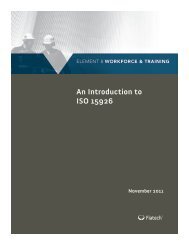Advancing Interoperability for the Capital Projects ... - iRINGToday
Advancing Interoperability for the Capital Projects ... - iRINGToday
Advancing Interoperability for the Capital Projects ... - iRINGToday
You also want an ePaper? Increase the reach of your titles
YUMPU automatically turns print PDFs into web optimized ePapers that Google loves.
Figure 1: Components of Building Industry’s In<strong>for</strong>mation Delivery Manual (IDM) 8<br />
In<strong>for</strong>mation Management—The Devil is in <strong>the</strong> Details <br />
As in<strong>for</strong>mation technology (IT) continues to advance, <strong>the</strong> ability to represent, store, and share <br />
in<strong>for</strong>mation is possible in an unprecedented fashion. Enhanced business value is attainable if industry <br />
uses IT to advance interoperability and use standardized, structured IE specifications. IEs need to be <br />
supported by a robust interoperability 9 architecture based on industry standards to provide <strong>the</strong> <br />
capabilities <strong>for</strong> all stakeholders to interoperate openly. In<strong>for</strong>mation Management (data specifications, <br />
standards, and testing) allows <strong>for</strong> <strong>the</strong> exchange, coordination, tracking, and synchronization of <br />
in<strong>for</strong>mation without <strong>the</strong> issues of integrity or security. <br />
Many sources of in<strong>for</strong>mation are involved in capturing project (design and construction) <br />
in<strong>for</strong>mation: schematic data (2D), 3D model in<strong>for</strong>mation (spatial location and size), design preferences <br />
(typically database/datasheets), supplier catalogues, building codes, inspection/installation instructions, <br />
etc. Synchronizing <strong>the</strong>se sources to ensure consistency is a major challenge. Assessing <strong>the</strong> in<strong>for</strong>mation <br />
<strong>for</strong> accuracy is ano<strong>the</strong>r of <strong>the</strong> challenges as well as <strong>the</strong>n “abstracting, extracting, viewing, or <br />
<strong>for</strong>mulating” <strong>the</strong> in<strong>for</strong>mation into a <strong>for</strong>mat <strong>for</strong> <strong>the</strong> intended purpose and also repurposing. <br />
Different data views, meanings, and relationships necessitate that in<strong>for</strong>mation management go to a <br />
deeper level to resolve ambiguity. Specific industry IE purposes require <strong>the</strong> object in<strong>for</strong>mation (both <br />
syntactic and semantic) to be extracted. Agreement on <strong>the</strong> types, hierarchy, and content of <strong>the</strong> <br />
in<strong>for</strong>mation objects define <strong>the</strong> in<strong>for</strong>mation that must be associated with each object type. The following <br />
two industry standards approach and resolve this differently: <br />
• The BIM (ISO/PAS 16739) approach is to use schemas and to develop <strong>the</strong> processes (In<strong>for</strong>mation <br />
Delivery Manual) that define <strong>the</strong> IEs that are desired <strong>for</strong> each purpose (model views) in <br />
addition to object types. The process through which model views can be proposed, agreed to <br />
<strong>Interoperability</strong> Vision Paper <strong>for</strong> Broad Industry Comment <br />
Page 5 of 13 <br />
Copyright © 2012 Fiatech.



